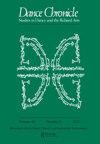罗斯玛丽·罗伯茨的《难以忍受的性感:嘻哈舞、身体、种族和权力》中的社会幽灵和集体
IF 0.1
3区 艺术学
0 DANCE
引用次数: 0
摘要
《难以忍受的性感:嘻哈舞蹈、身体、种族和力量》一书对嘻哈舞蹈和表演的学术研究做出了深刻而必要的贡献。这是罗斯玛丽·罗伯茨的第一本著作,她在之前的研究中扩展了具体教学法、与社会幽灵共舞、黑人和棕色人的身体作为知识场所等方面的重点。通过社会心理学、人类学和舞蹈研究的跨学科方法,罗伯茨分析了舞蹈和运动,以质疑人们看待和书写身体的方式。特别是,她的作品挑战了从舞蹈到人类学等领域对身体力量的限制,特别是对集体身体的限制,更具体地说是对黑人和棕色人种的限制。Roberts从舞蹈和表演研究学者Randy Martin, Deidre Sklar, Thomas DeFrantz和Imani Kai Johnson等人的作品中汲取灵感,并将她的人种学研究集中在Jacob 's Pillow的2009年Hip Hop Continuum学校,其中包括嘻哈舞蹈从业者Rennie Harris, Moncell Durden, Mr. Wiggles, Marjory Smarth, Ynot和西非舞蹈从业者Cachet Ivey。罗伯茨这本书的优势在于她对白人目光物化的批判,以及她将黑人和棕色人种的身体重新置于语境中的扩展的感官方法。在嘻哈舞蹈中,就像在其他非洲移民舞蹈形式中一样,黑人和棕色人种的身体携带着他们种族化的历史和性感,可以通过超越以眼睛为中心的方法来“看到”,也就是说,一种特权视觉的方法。本文章由计算机程序翻译,如有差异,请以英文原文为准。
Social Ghosts and Collective Bodies in Rosemarie Roberts’ Baring Unbearable Sensualities: Hip Hop Dance, Bodies, Race, and Power
Baring Unbearable Sensualities: Hip Hop Dance, Bodies, Race, and Power offers a profoundly insightful and necessary contribution to the growing scholarship of Hip Hop dance and performance. This first book by Rosemarie Roberts extends key points in her previous research on embodied pedagogies, dancing with social ghosts, and Black and Brown bodies as sites of knowledge. Through an interdisciplinary approach of social psychology, anthropology, and dance studies, Roberts analyzes dance and movement to problematize the ways in which the body is seen and written. In particular, her work challenges how the fields ranging from dance to anthropology have set limitations on the power of the body, in particular on collective bodies, and more specifically on Black and Brown bodies. Roberts draws from the works of dance and performance studies scholars Randy Martin, Deidre Sklar, Thomas DeFrantz, and Imani Kai Johnson, among others, and centers her ethnographic research on The School at Jacob’s Pillow’s 2009 Hip Hop Continuum which featured Hip Hop dance practitioners Rennie Harris, Moncell Durden, Mr. Wiggles, Marjory Smarth, Ynot, and West African dance practitioner Cachet Ivey. The strengths of Roberts’ book are her critique of the objectifying white gaze and her expanded sensorial approach that (re)contextualizes Black and Brown bodies. In Hip Hop dance, as in other Afro-diasporic dance forms, Black and Brown bodies carry their racialized histories and sensualities that can be “seen” by moving beyond an ocularcentric approach, that is, an approach that privileges the sense of sight.
求助全文
通过发布文献求助,成功后即可免费获取论文全文。
去求助
来源期刊

DANCE CHRONICLE
DANCE-
CiteScore
0.40
自引率
0.00%
发文量
22
期刊介绍:
For dance scholars, professors, practitioners, and aficionados, Dance Chronicle is indispensable for keeping up with the rapidly changing field of dance studies. Dance Chronicle publishes research on a wide variety of Western and non-Western forms, including classical, avant-garde, and popular genres, often in connection with the related arts: music, literature, visual arts, theatre, and film. Our purview encompasses research rooted in humanities-based paradigms: historical, theoretical, aesthetic, ethnographic, and multi-modal inquiries into dance as art and/or cultural practice. Offering the best from both established and emerging dance scholars, Dance Chronicle is an ideal resource for those who love dance, past and present. Recently, Dance Chronicle has featured special issues on visual arts and dance, literature and dance, music and dance, dance criticism, preserving dance as a living legacy, dancing identity in diaspora, choreographers at the cutting edge, Martha Graham, women choreographers in ballet, and ballet in a global world.
 求助内容:
求助内容: 应助结果提醒方式:
应助结果提醒方式:


